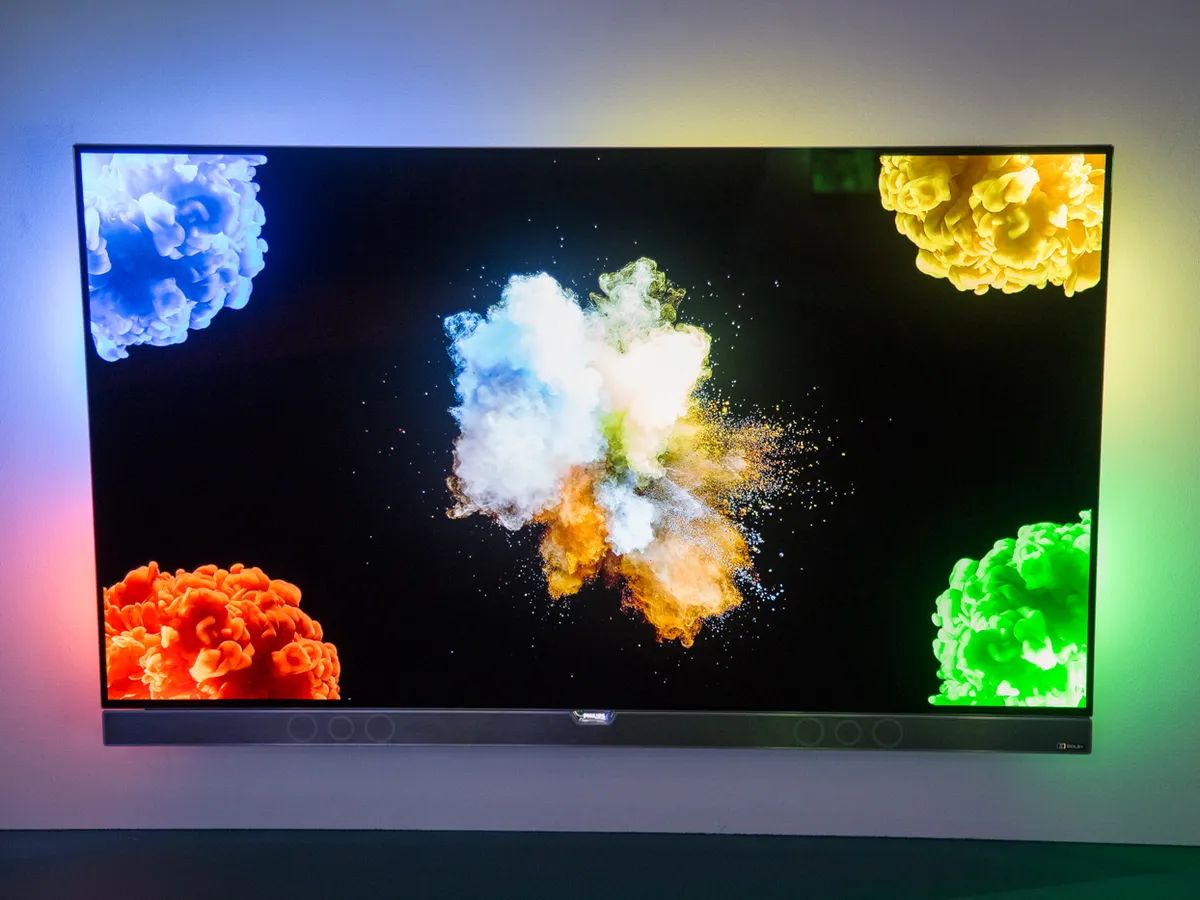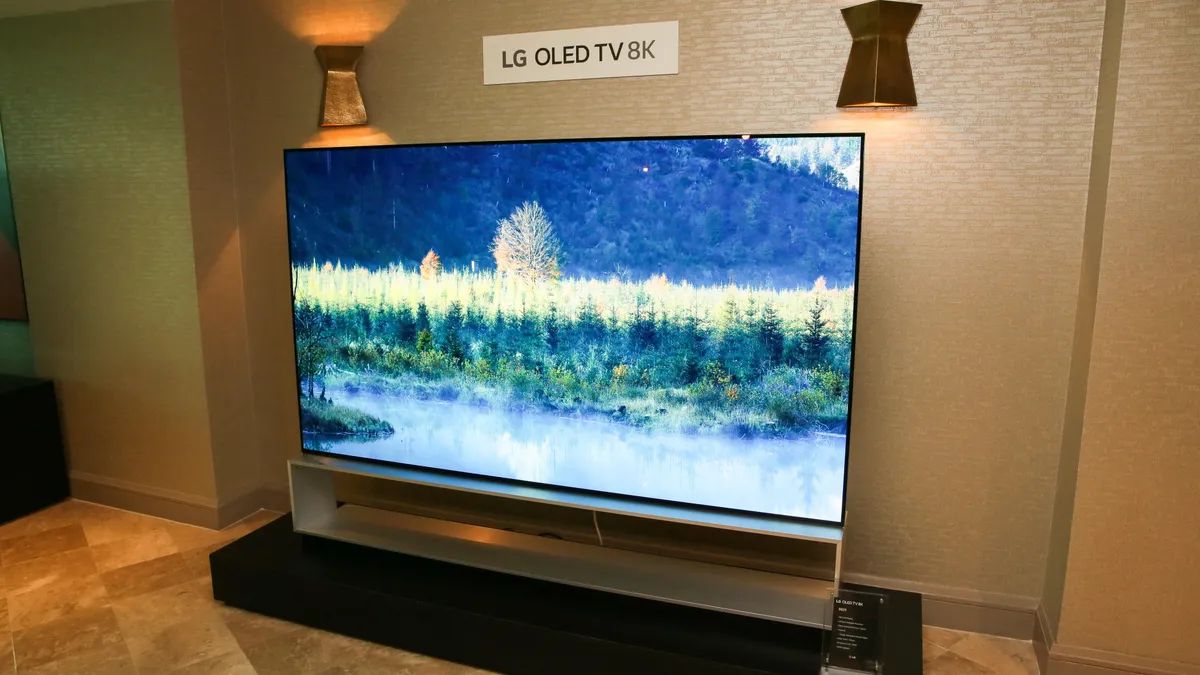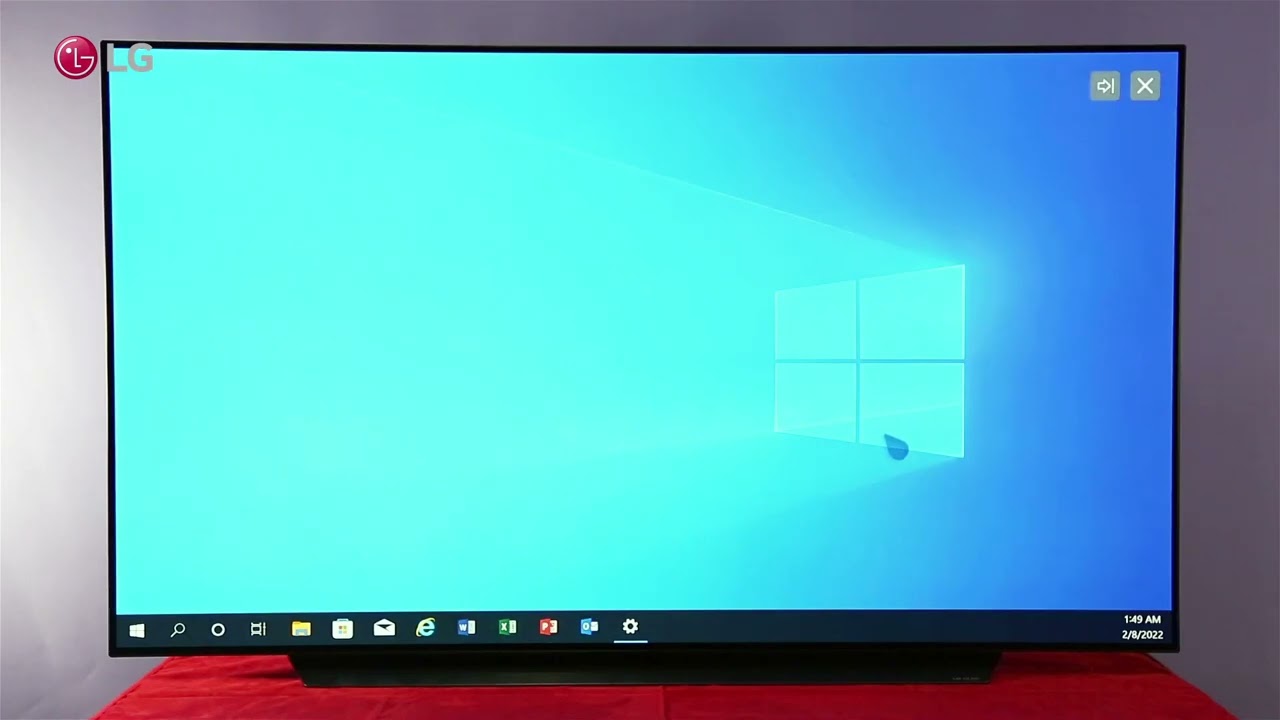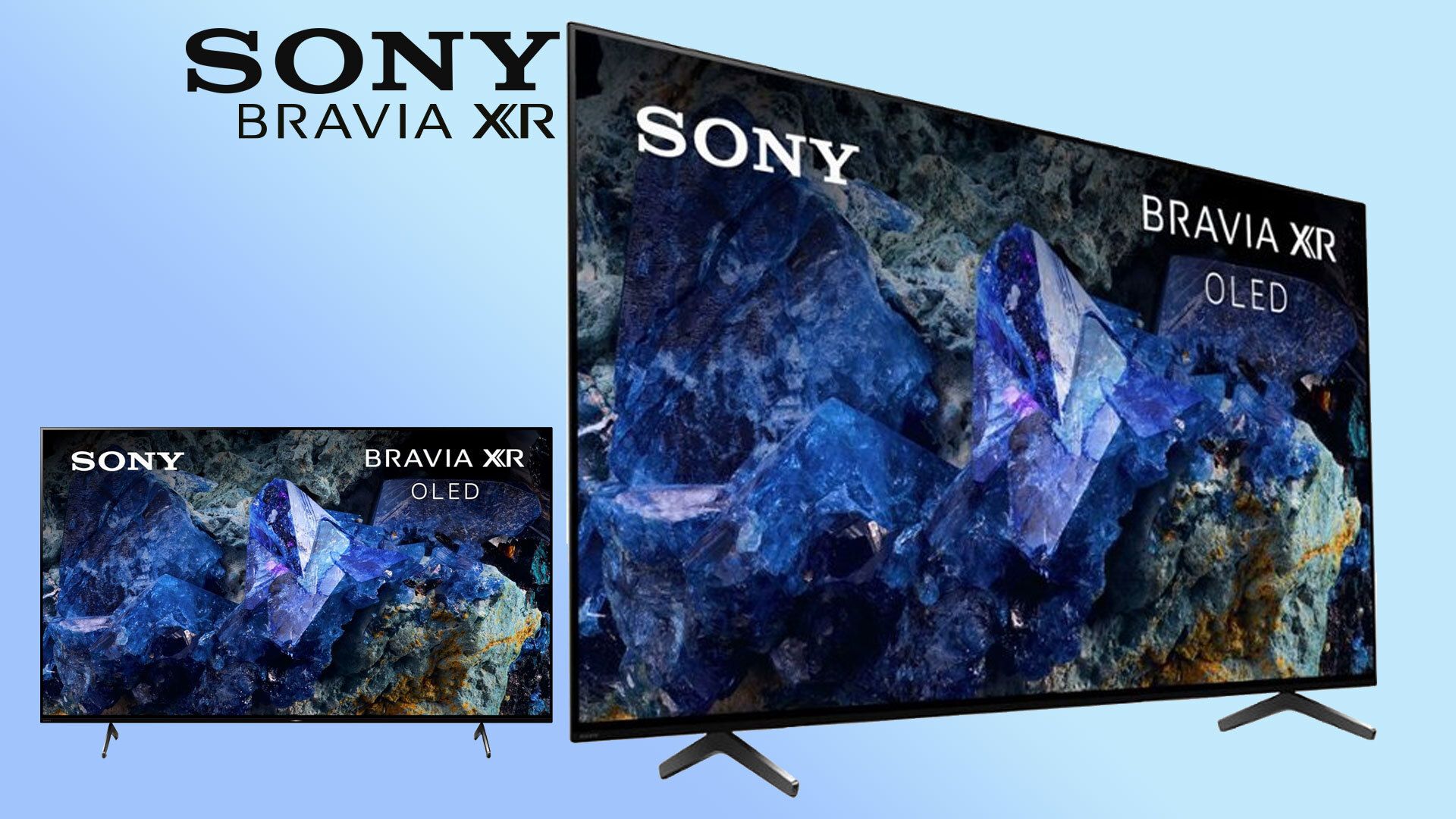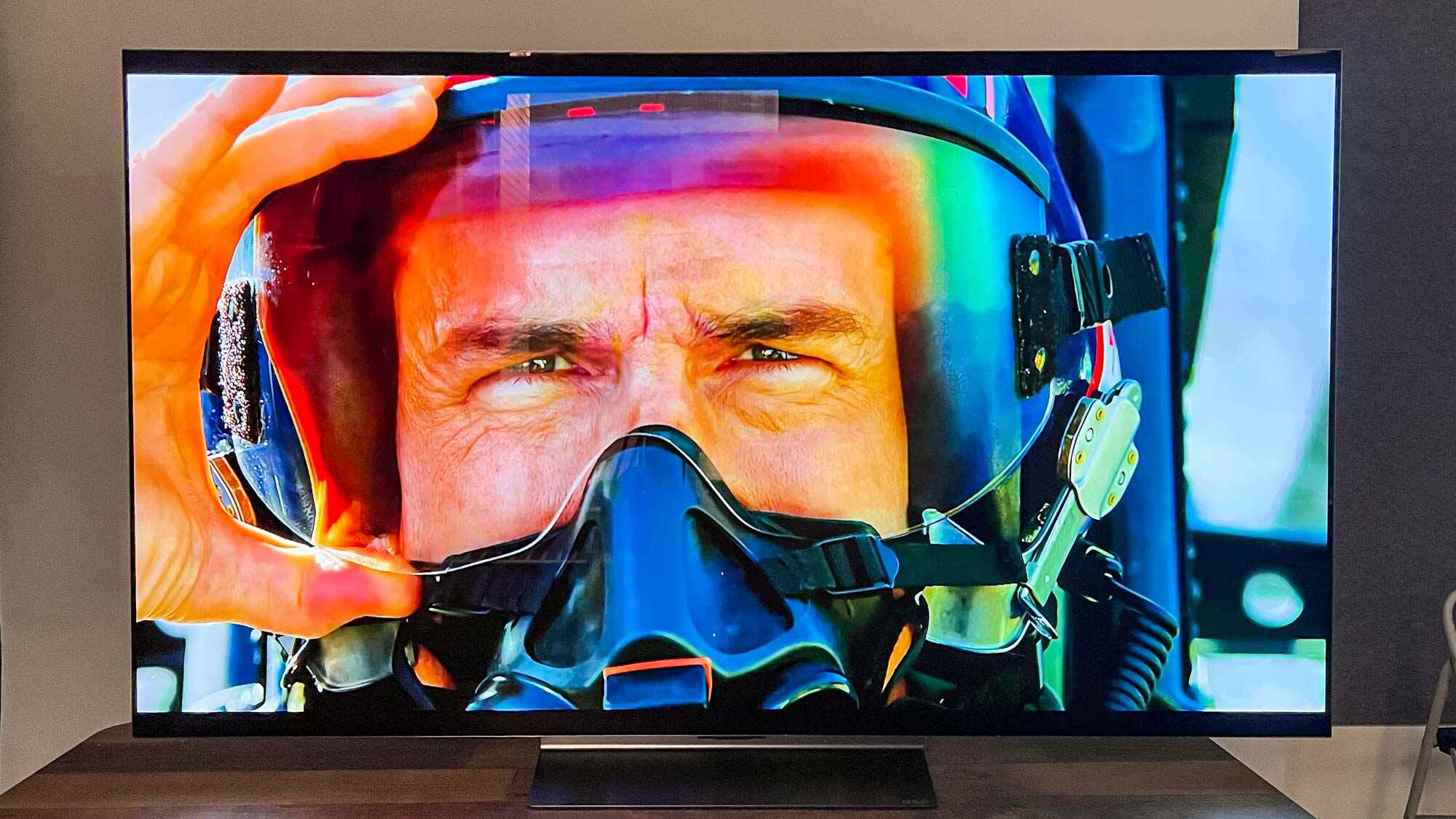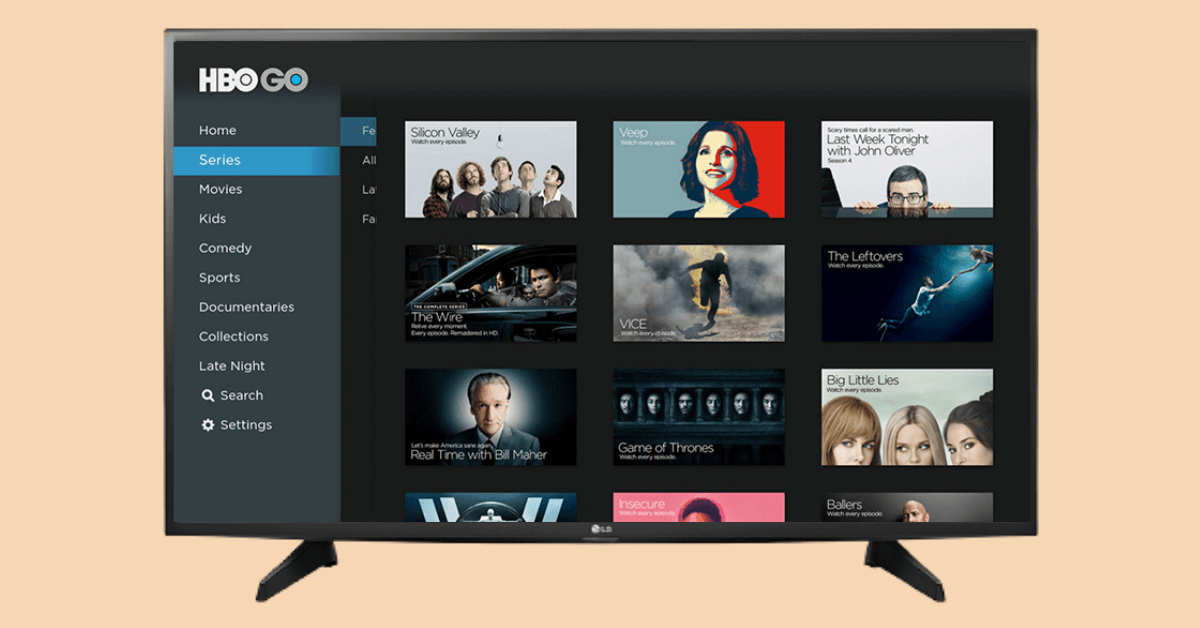Introduction
Welcome to the world of OLED TVs! If you’re in the market for a new television, you’ve probably come across the term “OLED” and might be wondering what all the hype is about. OLED, which stands for Organic Light Emitting Diode, is a display technology that has revolutionized the way we experience visuals on our screens.
Unlike traditional LCD/LED TVs, which rely on a backlight to illuminate the pixels, OLED TVs are made up of millions of self-illuminating pixels that can individually turn on or off. This means that each pixel can produce accurate colors, deep blacks, and incredible contrast, resulting in a truly stunning picture quality.
In addition to the impressive visuals, OLED technology also offers other benefits that make it a popular choice among videophiles and home entertainment enthusiasts. From vibrant colors to slim designs, OLED TVs have quickly become a sought-after option for those who crave the ultimate viewing experience.
However, before you rush out to purchase an OLED TV, it’s important to consider a few factors to ensure it’s the right choice for your needs. This guide will walk you through the key features and considerations to keep in mind when deciding if and when to buy an OLED TV.
So, if you’re ready to immerse yourself in the world of cutting-edge display technology, let’s dive deeper into the benefits of OLED TVs and the factors to consider before making a purchase.
Understanding OLED Technology
Before delving into the specifics of OLED TVs, it’s essential to understand the technology behind them. OLED, or Organic Light Emitting Diode, is a type of display technology that uses organic compounds to emit light when an electric current is passed through them.
The key difference between OLED and traditional LCD/LED screens lies in how they produce light. In an LCD/LED TV, a backlight is employed to illuminate the pixels on the screen. This can lead to certain limitations, such as uneven backlighting, resulting in less accurate colors and limited contrast.
On the other hand, OLED TVs consist of individual organic compounds that emit light when activated. This means that each pixel can emit its own light, resulting in pure blacks, infinite contrast ratios, and vibrant colors that are unmatched by other display technologies.
Another advantage of OLED technology is its ability to achieve an incredibly fast response time. Since the pixels can turn on and off individually, OLED TVs can display fast-moving action with remarkable clarity and minimal motion blur. This makes them an excellent choice for gaming, sports, and action-packed movies.
Moreover, OLED technology also allows for an ultra-thin design. As there is no need for a separate backlighting layer, OLED panels can be made incredibly thin and flexible, enabling manufacturers to create TVs with sleek form factors that can blend seamlessly into any living space.
It’s worth mentioning that OLED technology has also paved the way for innovative display features like curved screens and rollable displays. With their bendable characteristics, OLED screens offer new possibilities in terms of design and versatility.
In summary, OLED technology is a game-changer in the world of visual displays. Its ability to deliver rich and lifelike colors, deep blacks, and exceptional contrast, along with its ultra-thin design and fast response times, makes OLED TVs a top choice for those seeking the best possible viewing experience.
Benefits of OLED TVs
OLED TVs offer a range of benefits that make them stand out in the world of display technology. From superior picture quality to sleek designs, here are some of the key advantages of choosing an OLED TV:
1. Perfect black levels and infinite contrast:
With individual pixels that can emit their own light or turn off completely, OLED displays can achieve perfect black levels and infinite contrast ratios. This means that dark scenes appear truly black, enhancing the overall picture quality and delivering a more immersive viewing experience.
2. Accurate and vibrant colors:
OLED technology provides exceptional color accuracy and wide color gamut support. Each pixel can emit light independently, resulting in vibrant and true-to-life colors. Whether you’re watching a nature documentary or a Hollywood blockbuster, OLED TVs can reproduce colors with incredible precision.
3. Wide viewing angles:
Unlike LCD/LED displays that suffer from color and contrast degradation when viewed from the sides, OLED TVs maintain consistent picture quality from all angles. This means that you can enjoy stunning visuals no matter where you’re seated in the room, making OLED ideal for large gatherings or living room setups with multiple viewing positions.
4. Ultra-fast response time:
OLED technology enables exceptionally fast response times, virtually eliminating motion blur in fast-paced action scenes. Whether you’re playing video games or watching sports, OLED ensures smooth and fluid motion, enhancing your enjoyment and immersing you in the action.
5. Slim and flexible design:
Thanks to the absence of a separate backlighting layer, OLED TVs can be made incredibly thin and lightweight. This not only adds to the aesthetic appeal but also offers more flexibility in terms of installation options. You can easily mount an OLED TV on a wall or even consider curved or rollable OLED displays for a truly unique viewing experience.
6. Energy-efficient operation:
Since OLED displays only emit light when necessary, they are more energy-efficient compared to LCD/LED TVs. With OLED, you can enjoy a stunning visual experience while being conscious of your energy consumption.
Overall, the benefits of OLED TVs, including perfect black levels, accurate colors, wide viewing angles, fast response times, slim designs, and energy efficiency, make them a top choice for those seeking the ultimate home entertainment experience.
Considerations Before Buying an OLED TV
While OLED TVs offer incredible picture quality and a host of benefits, it’s important to carefully consider a few factors before making a purchase. Here are some key considerations to keep in mind:
1. Budget considerations:
OLED TVs tend to be more expensive compared to LCD/LED counterparts. Before diving into the OLED market, evaluate your budget and determine how much you are willing to spend. It’s worth noting that prices for OLED TVs have been gradually decreasing over the years, making them more accessible, but they can still be a significant investment.
2. HDMI 2.1 and future-proofing:
Check if the OLED TV you’re considering supports HDMI 2.1, the latest industry standard for high-definition video and audio. HDMI 2.1 enables features like higher refresh rates, Variable Refresh Rate (VRR), and Auto Low Latency Mode (ALLM), which are particularly appealing for gamers. Investing in an HDMI 2.1 compatible OLED TV will ensure that you can take advantage of future technologies and gaming consoles without needing to upgrade your TV.
3. Gaming and OLED:
If you’re a gaming enthusiast, OLED TVs can provide an exceptional gaming experience. The ultra-fast response times and enhanced contrast can make games come alive on your screen. Consider features like HDMI 2.1, VRR, and ALLM mentioned earlier to maximize gaming performance. Also, be aware of potential risks such as screen burn-in, which may occur with static images displayed for prolonged periods. However, most modern OLED TVs have built-in features to address and mitigate this issue.
4. HDR and OLED:
OLED TVs excel in displaying High Dynamic Range (HDR) content, which offers a wider range of colors and increased contrast for a more lifelike visual experience. When purchasing an OLED TV, ensure that it supports the HDR format of your choice, such as HDR10 or Dolby Vision, to fully enjoy HDR-enabled content.
5. OLED vs. LCD/LED:
Consider the specific features and advantages of OLED technology compared to LCD/LED. While OLED offers unparalleled picture quality, LCD/LED TVs might be a better fit for those on a tighter budget or those who prioritize features like brightness levels for well-lit rooms.
6. Content and OLED:
Take into account the type of content you primarily watch. If you mostly watch movies or visually stunning content, OLED’s superior contrast and color accuracy will enhance your viewing experience. However, if you predominantly watch news or sports programming with static logos or tickers, be mindful of the potential risk of screen burn-in.
By considering these factors before buying an OLED TV, you can ensure that you make an informed decision that aligns with your budget, preferences, and viewing habits. Remember to also compare different models, read reviews, and seek expert advice to find the perfect OLED TV that suits your needs.
Budget Considerations
When it comes to purchasing an OLED TV, budget is an important factor to consider. While OLED technology offers exceptional picture quality, it does come at a higher price compared to traditional LCD/LED TVs. Here are some key points to keep in mind when evaluating your budget:
1. Determine your spending limit:
Start by setting a budget for your new TV. Consider how much you’re willing to invest in an OLED TV and determine the maximum amount you can afford. Keep in mind that OLED TVs are generally more expensive than their LCD/LED counterparts, so it’s important to have a realistic expectation of your budget.
2. Look for deals and discounts:
Keep an eye out for sales, special promotions, and discounts. Retailers often offer discounts on electronics during holiday seasons or as part of clearance events. Additionally, consider refurbished or open-box options, which can offer significant savings compared to buying brand new.
3. Prioritize screen size:
Screen size plays a significant role in the price of a TV. Larger OLED TVs tend to be more expensive, so consider the ideal screen size for your viewing environment and entertainment needs. Remember, it’s better to have a high-quality smaller display than a low-quality large one.
4. Research different brands and models:
Explore various brands and models within your price range. While OLED panels are usually sourced from a few manufacturers, different brands can offer varying features, build quality, and pricing options. Read reviews, compare specifications, and analyze value for money to find the best OLED TV that meets your requirements and budget.
5. Consider older models:
Newer OLED models tend to be more expensive due to the latest advancements and features. However, previous-generation OLED TVs can still provide outstanding picture quality at a more affordable price. Consider opting for an older model that supports the features and technology you desire, without necessarily breaking the bank.
6. Future-proofing:
While budget-consciousness is important, it’s also worth considering the longevity and future-proofing of your investment. Investing in an OLED TV with modern features like HDMI 2.1 and advanced gaming capabilities can ensure that you can enjoy upcoming technology advancements without the need for immediate upgrades.
By carefully considering your budget and exploring the available options, you can find the right OLED TV that not only meets your visual expectations but also aligns with your financial considerations. Remember to strike a balance between affordability and the features that matter most to you in order to make a well-informed purchase decision.
HDMI 2.1 and Future-Proofing
When considering the purchase of an OLED TV, it’s important to take into account the connectivity options and future-proofing features. One crucial aspect to consider is whether the TV supports HDMI 2.1, the latest standard for high-definition audio and video transmission. Here’s why HDMI 2.1 and future-proofing are worth considering:
1. Enhanced video and audio capabilities:
HDMI 2.1 offers several significant improvements over its predecessor, HDMI 2.0. It supports higher video resolutions, including 4K at 120Hz and 8K at 60Hz, making it compatible with the latest high-resolution content. Additionally, HDMI 2.1 offers increased bandwidth, enabling features like Variable Refresh Rate (VRR) and Auto Low Latency Mode (ALLM).
2. Variable Refresh Rate (VRR):
VRR is a feature supported by HDMI 2.1 that eliminates screen tearing and stuttering during gameplay. By synchronizing the refresh rate of the TV with the output from a gaming console or PC, VRR provides a smoother and more immersive gaming experience. If you’re a gaming enthusiast, having an OLED TV with HDMI 2.1 and VRR support can enhance your gameplay.
3. Auto Low Latency Mode (ALLM):
ALLM is another feature enabled by HDMI 2.1 that automatically switches your OLED TV to its lowest input lag mode when it detects a gaming signal. This reduces input lag, ensuring that your commands are executed instantly and improving responsiveness during gaming sessions.
4. Future technology compatibility:
Investing in an OLED TV with HDMI 2.1 ensures that you can take advantage of future technologies and content. As gaming consoles, streaming services, and other devices advance, they are likely to support HDMI 2.1 for optimal performance. By future-proofing your TV, you can enjoy the latest features without needing to upgrade your display in the near future.
5. Connectivity options:
HDMI 2.1 also offers additional connectivity options, such as eARC (Enhanced Audio Return Channel), which supports higher-quality audio formats like Dolby TrueHD and DTS-HD Master Audio. This can enhance your audio experience when connected to compatible soundbars or home theater systems.
6. Compatibility considerations:
It’s important to note that not all HDMI 2.1 features are universally supported by all devices. Before purchasing an OLED TV with HDMI 2.1, ensure that the gaming console, Blu-ray player, or other devices you plan to connect to it also support HDMI 2.1 to fully leverage its capabilities.
By opting for an OLED TV with HDMI 2.1 compatibility, you can enjoy the latest video and audio features, future-proof your investment, and ensure compatibility with upcoming devices and content. While HDMI 2.1 may not be an immediate necessity for everyone, considering future technology advancements can be a wise decision when investing in a high-quality OLED TV.
Gaming and OLED
If you’re an avid gamer, choosing an OLED TV can significantly enhance your gaming experience. The combination of OLED technology’s exceptional picture quality and specific gaming features make OLED TVs a popular choice for gamers. Here’s why gaming and OLED go hand in hand:
1. Ultra-fast response time:
One of the standout features of OLED technology is its ultra-fast response time. Each pixel can turn on or off individually, resulting in minimal motion blur and lag. This means that fast-paced action scenes in games appear smooth and fluid, allowing you to react quickly and immerse yourself in the gameplay.
2. Perfect black levels and contrast:
Rich black levels and contrast are crucial for gaming, as they enhance the detail and depth of the visuals. OLED displays excel in this area, as each pixel can emit its own light or turn off completely. This ability to achieve perfect black levels enhances shadow details, making dark scenes in games more realistic and atmospheric.
3. Vibrant colors and accurate visuals:
OLED technology delivers outstanding color accuracy and wide color gamut support. Each pixel can emit light independently, resulting in vibrant and true-to-life colors. This allows game developers’ artistic vision to come to life, making gaming worlds more visually captivating and immersive.
4. Variable Refresh Rate (VRR):
HDMI 2.1, commonly found in newer OLED TVs, supports VRR. VRR syncs the refresh rate of the TV with the output from a gaming console or PC, reducing screen tearing and stuttering. This feature ensures smooth and tear-free gameplay, providing a more enjoyable and immersive gaming experience.
5. Auto Low Latency Mode (ALLM):
OLED TVs with HDMI 2.1 may feature ALLM, which automatically switches the TV to its lowest input lag mode when a gaming signal is detected. This minimizes input lag, ensuring that your commands are executed with minimal delay. ALLM enhances responsiveness and precision, crucial factors for competitive gaming or precise timing in action-packed games.
6. HDR gaming:
OLED TVs are also capable of displaying High Dynamic Range (HDR) content, offering a wider range of colors and increased contrast. HDR gaming provides more realistic lighting, immersive environments, and stunning visuals. Many modern games are designed with HDR support, and OLED technology can showcase these games in their full glory.
When it comes to gaming, OLED TVs provide an exceptional visual experience due to their fast response times, impressive contrast ratios, and vibrant colors. Do keep in mind that OLEDs, like any other screen, can potentially suffer from screen burn-in with static images displayed for prolonged periods. However, most modern OLED TVs implement technologies like pixel shifting to mitigate this issue for regular gaming use.
By choosing an OLED TV that supports HDMI 2.1 and offers gaming-focused features like VRR and ALLM, gamers can maximize their enjoyment and immerse themselves into their favorite gaming worlds with stunning visuals and ultra-responsive gameplay.
HDR and OLED
High Dynamic Range (HDR) is a technology that allows for a wider range of colors, increased contrast, and more realistic lighting in video content. When it comes to HDR, OLED displays shine, delivering breathtaking visuals and an enhanced viewing experience. Let’s explore why HDR and OLED are a winning combination:
1. Expanded color range and accuracy:
OLED technology’s ability to emit light on a pixel-by-pixel basis allows for a wider color gamut and enhanced color accuracy. This means that OLED TVs can reproduce a greater variety of colors with precision and vibrancy, bringing visuals to life in a way that is pleasing to the eye.
2. Deeper blacks and increased contrast:
OLED’s self-emissive pixels allow for perfect blacks, resulting in infinite contrast ratios. When combined with HDR content, OLED TVs can display a wider range of luminosity, ensuring that both dark and bright areas of an image are displayed with greater detail and depth. This results in more realistic images and a higher level of immersion during HDR playback.
3. Enhanced detail and highlights:
The combination of OLED’s deep blacks, bright highlights, and expanded color range allows for greater detail in HDR content. Subtle details in shadowy areas become more visible, while bright elements, such as the sun or reflections, appear more radiant and realistic. This dynamic range provided by HDR on OLED panels creates a more captivating and lifelike viewing experience.
4. Improved brightness levels:
OLED displays have improved their brightness capabilities compared to earlier models. While not as bright as some LCD/LED displays, OLED panels can still achieve high peak brightness levels necessary to showcase HDR content effectively. This ensures that HDR scenes are displayed with the intended brightness and intensity, resulting in a visually stunning picture.
5. HDR formats and compatibility:
OLED TVs generally support multiple HDR formats, such as HDR10, Dolby Vision, or HLG (Hybrid Log-Gamma). This ensures compatibility with a wide range of HDR content from streaming services, Blu-ray discs, and gaming consoles. Having an OLED TV that supports various HDR formats allows you to enjoy HDR content from different sources and take full advantage of the HDR capabilities of your OLED display.
6. Viewing experience:
HDR content on OLED displays provides a truly immersive viewing experience. Whether you’re watching movies with stunning landscapes, engaging in gaming adventures with vibrant environments, or enjoying nature documentaries with breathtaking visuals, the combination of HDR and OLED technology elevates the visuals to a whole new level, offering a closer representation of real-world colors and lighting conditions.
In summary, OLED displays excel in showcasing HDR content, offering expanded color range, deeper blacks, increased contrast, improved brightness levels, and an enhanced viewing experience overall. With the ability to reproduce a wider range of colors and deliver stunning visuals, OLED’s compatibility with various HDR formats makes it a fantastic choice for those seeking a truly captivating visual experience.
OLED vs. LCD/LED
When it comes to choosing a television, you’ll likely encounter the dilemma of OLED vs. LCD/LED. While both technologies offer their own advantages, OLED stands out as a superior choice in several key areas. Let’s compare OLED and LCD/LED TVs to help you make an informed decision:
1. Picture Quality:
OLED technology provides unparalleled picture quality. With self-emissive pixels, OLED displays can achieve perfect blacks and infinite contrast ratios. This results in more vibrant colors, enhanced detail in both dark and bright areas, and a more immersive viewing experience. LCD/LED TVs, on the other hand, rely on a backlight, which can lead to less accurate colors and limited contrast performance.
2. Contrast Ratio:
OLED TVs have an advantage over LCD/LED in terms of contrast ratio. Each pixel in an OLED display can individually turn on or off, allowing for a much higher dynamic range and better control over black levels. LCD/LED panels struggle to achieve the same level of contrast due to the reliance on a backlight, resulting in slightly washed-out blacks and less pronounced contrast.
3. Viewing Angles:
OLED displays offer superior viewing angles compared to LCD/LED screens. With OLED, colors and contrast remain consistent and accurate regardless of the viewing position. This makes OLED ideal for large gatherings or living room setups with multiple seating arrangements. LCD/LED screens can experience color and contrast distortions when viewed from off-center angles.
4. Response Time:
OLED technology has an advantage in terms of response time. Each OLED pixel can turn on or off almost instantaneously, resulting in minimal motion blur and smooth action. This makes OLED ideal for fast-paced gaming and sports. LCD/LED displays often exhibit higher response times, leading to slight blur during fast movement.
5. Slim Design:
OLED TVs have an ultra-slim design that is a result of the lack of a separate backlighting layer. This allows for sleek and minimalist aesthetics, making OLED TVs a stylish addition to any living space. LCD/LED TVs are generally thicker due to the need for a backlight, resulting in a bulkier design.
6. Energy Efficiency:
When it comes to energy efficiency, OLED displays have an advantage. As each OLED pixel can individually turn on or off, OLED TVs consume less power when displaying darker scenes, which typically results in energy savings. LCD/LED TVs require a constant backlight, leading to higher power consumption regardless of the content being displayed.
While LCD/LED technology still has its merits, OLED stands out for its superior picture quality, contrast ratio, wider viewing angles, faster response times, slim design, and energy efficiency. Although OLED TVs can be more expensive, the benefits they bring to the table make them a worthwhile investment for those seeking the best visual experience.
Content and OLED
When it comes to enjoying various types of content, OLED TVs offer a remarkable visual experience. Whether you’re watching movies, TV shows, gaming, or even editing photos or videos, OLED technology enhances the quality of the content in several ways. Let’s explore how content and OLED complement each other:
1. Movies and TV shows:
OLED displays are known for their ability to deliver deep blacks and vibrant colors, making them ideal for watching movies and TV shows. The perfect blacks achieved by OLED technology enhance the contrast and shadow details, providing a more immersive cinematic experience. Additionally, OLED’s wide color gamut ensures accurate color reproduction, ensuring that movies and TV shows look exactly as intended by the filmmakers.
2. Gaming:
Gaming on OLED displays is a treat for gamers. The combination of OLED’s fast response time, vibrant colors, and deep blacks creates a visually stunning gaming experience. Whether you’re exploring vast open worlds or engaging in intense multiplayer battles, OLED technology makes games come alive, with rich details and immersive visuals.
3. HDR content:
OLED displays excel in showcasing High Dynamic Range (HDR) content. HDR enhances the range between the darkest and brightest parts of an image, making it more vibrant and lifelike. OLED’s ability to produce perfect blacks and achieve high contrast ratios allows for the full potential of HDR content to be realized. Whether you’re streaming HDR movies, playing HDR-enabled games, or viewing HDR photography, OLED technology ensures an exceptional visual experience.
4. Photo and video editing:
For professionals or enthusiasts in photography and videography, color accuracy and detail are crucial. OLED displays offer precise color reproduction, allowing for accurate editing and enhancing the visual details in photos and videos. The deep blacks and wide dynamic range also assist in fine-tuning shadow and highlight areas of the images.
5. Streaming and content consumption:
OLED TVs provide a visually captivating platform for streaming your favorite content. With their vibrant colors, accurate visuals, and high contrast, OLED displays elevate the streaming experience. Whether you’re enjoying a series on a streaming platform or browsing for viral videos on social media, OLED’s rich picture quality enhances every pixel on the screen.
6. Sports and live events:
Watching sports and live events on OLED displays is an immersive experience. The fast response times of OLED technology ensure smooth motion reproduction, capturing every detail and movement with precision. The vibrant colors and excellent contrast add to the excitement, making you feel like you’re right there in the stadium or arena.
In summary, OLED displays enhance the enjoyment of various types of content, from movies and TV shows to gaming, HDR, photo and video editing, streaming, and live events. The combination of OLED’s deep blacks, vibrant colors, and excellent contrast ratios allows for a visually stunning and immersive experience, making OLED TVs the top choice for content consumption and appreciation.
Conclusion
Choosing the right TV is an important decision, and when it comes to OLED TVs, there’s no denying the exceptional picture quality and immersive visual experience they offer. With their perfect blacks, vibrant colors, wide viewing angles, and fast response times, OLED displays have set a new standard in home entertainment.
From the stunning visuals of movies and TV shows to the captivating experience of gaming and the precise editing capabilities for photos and videos, OLED technology enhances various types of content in ways that other display technologies cannot match. The ability to showcase HDR content with its expanded color range and increased contrast further elevates the viewing experience.
Before purchasing an OLED TV, budget considerations and future-proofing options should be taken into account. Evaluating features like HDMI 2.1 compatibility, gaming capabilities, and HDR support can help you make an informed decision that suits your needs and preferences. Additionally, comparing different brands, models, and deals can help you find the perfect OLED TV within your budget.
While LCD/LED displays still have their advantages, OLED TVs consistently outperform them in terms of picture quality, contrast ratio, wide viewing angles, and response times. OLED’s slim design and energy efficiency are added benefits that contribute to their appeal.
In conclusion, OLED technology has revolutionized the TV viewing experience, offering breathtaking visuals, enhanced colors, and immersive content consumption. Whether you’re enjoying movies, diving into gaming adventures, editing content, or simply binging your favorite shows, OLED TVs provide an unparalleled visual treat that is sure to impress.







